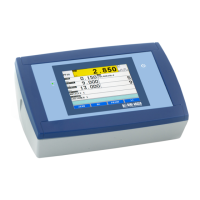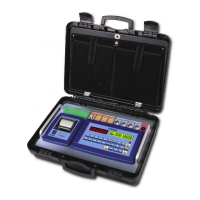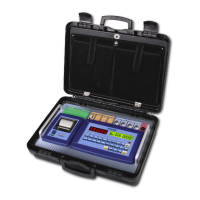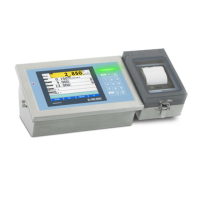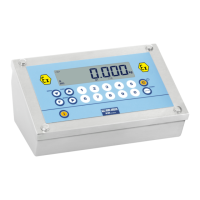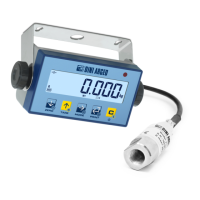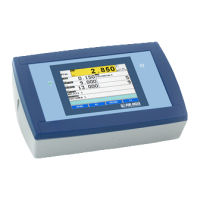
Do you have a question about the Dini Argeo 3590EGT Series and is the answer not in the manual?
| Brand | Dini Argeo |
|---|---|
| Model | 3590EGT Series |
| Category | Accessories |
| Language | English |
Describes the indicator's stainless steel case and physical dimensions for mounting.
Details the various connectors on the indicator for peripherals, serial lines, and power.
Explains the procedures and safety precautions for connecting and powering the instrument.
Step-by-step guide for powering on the weight indicator and its initial boot sequence.
Provides instructions on how to safely shut down the weight indicator.
Details the primary screens and user interface layout of the indicator's display.
Explains the meaning of various symbols and indicators shown on the display screen.
Describes the method for entering numerical data using the indicator's interface.
Details the process for entering text-based data using the indicator's interface.
Describes the procedure for setting the scale to a zero reference point before weighing.
Explains the different methods for taring the scale, including semiautomatic and preset tares.
Details the step-by-step process for performing a semiautomatic tare operation.
Explains how to set and use a predefined tare value for specific items or articles.
Describes associating a preset tare value with a specific article stored in the database.
Outlines the methods for removing or cancelling an active tare value from the scale.
Discusses the behavior of tare values regarding automatic cancellation on scale unload.
Details how to manage and input text fields such as OPERATOR, COMMENT, and LOT.
Introduces the management of articles and data within the indicator's internal database.
Provides step-by-step instructions on how to add new items and data to the database.
Explains the process for editing or updating existing entries within the database.
Details the procedure for deleting specific records or items from the database.
Describes how to search for database entries using alphanumeric characters.
Explains how to locate database entries by their specific index number for quick access.
Explains how to monitor and manage the system's operational status and detect errors.
Details the steps required to start, stop, and manage the automatic weighing process.
Outlines the sequence of operations and phases that occur during a standard weighing cycle.
Explains the different methods and configurations the instrument uses to capture weight readings.
Describes weight acquisition when the conveyor belt is halted and a sensor is utilized.
Provides an overview of the weighing system's components and their interaction during operation.
Details weight acquisition with the belt moving and utilizing a single photocell for detection.
Explains weight acquisition with the belt moving and using two photocells for precise timing.
Describes weight acquisition with the belt moving, relying on weight detection without photocells.
Explains how the instrument verifies if acquired weights fall within predefined tolerance limits.
Details setting tolerances based on article data and specific threshold values (T1, T2, T3).
Explains setting tolerances using minimum and maximum weight thresholds configured per article.
Describes setting tolerances without article management, using fast minimum and maximum thresholds.
Explains how to define the valid weight range by selecting negative and positive tolerance values.
Details how to perform volume checks using density coefficients instead of standard weight units.
Explains automatic adjustment of the target weight based on a series of consecutive valid weighings.
Details how to correct weights that fall outside the specified tolerance limits, often stopping the belt.
Describes options for handling out-of-tolerance weights without mandatory correction, allowing manual intervention.
Explains how to handle out-of-tolerance weights that require mandatory correction before proceeding.
Details how weight results are displayed and how they trigger linked output signals based on tolerance levels.
Explains how specific outputs are managed based on article configurations and tolerance settings.
Describes how to control the conveyor belts, including stopping them for specific conditions and restarting.
Details stopping belts for out-of-tolerance weighs or for manual product expulsion from the line.
Explains the procedure for stopping belts after each individual weighing operation for further processing.
Describes stopping belts after a specified count of consecutive out-of-tolerance weights.
Explains how products are moved from the weighing area and automatically expelled from the system.
Details the automatic zeroing function for the weighing belt to maintain accuracy between cycles.
Covers handling situations where a weighing cycle is interrupted or a product is not properly weighed.
Explains how blocks in the downstream system can automatically disable the weighing cycle.
Describes how emergency signals or motor lock conditions can instantly halt the weighing cycle.
Details how detection of underload or overload conditions locks the weighing cycle for safety.
Provides instructions for restoring the weighing cycle and its state after a power interruption.
Explains how the cadence photocell and belt manage pack flow, spacing, and timing.
Details the conditions that trigger alarms and how these alarms manage the system's output signals.
Details setting an additional value that is summed with each totalization for reporting.
Explains setting the number of digits for progressive ticket and lot counters for display.
Describes managing and clearing the ticket progressive counter for sequential numbering.
Explains managing and clearing the automatic lot progressive counter for batch tracking.
Outlines the terms and conditions of the two-year manufacturer's warranty for the instrument.

